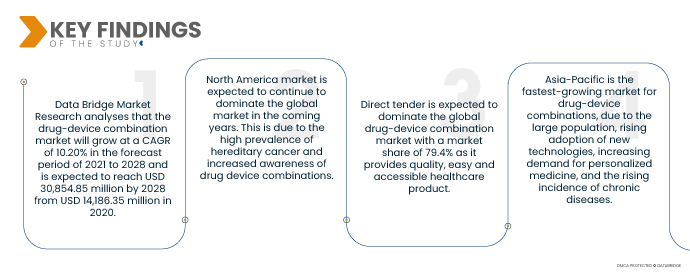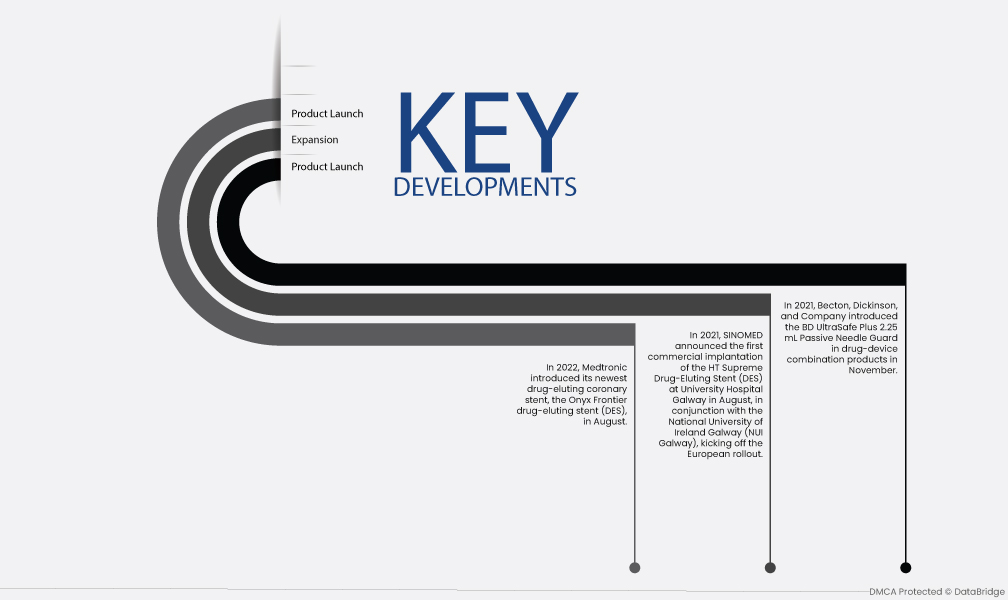The frequent engagement of government health organizations ensures the highest level of patient safety. The United States Food and Drug Administration (FDA) established the Office of Combination Products (OCP) to address the problems associated with drug-device combination products and to allow effective and consistent regulation. Furthermore, multinational pharmaceutical companies are expected to create clinical medications and devices at an unprecedented rate to address the demand for enhanced medication delivery systems.
Access Full Report @ https://www.databridgemarketresearch.com/ru/reports/global-drug-device-combination-market
Data Bridge Market Research analyses that the Drug-Device Combination Market will grow at a CAGR of 10.20% in the forecast period of 2021 to 2028 and is expected to reach USD 30,854.85 million by 2028 from USD 14,186.35 million in 2020. The global population is aging, and this is leading to an increase in the prevalence of chronic diseases. Drug-device combinations can be a more effective way to treat these diseases than traditional drug therapy. Drug-device combinations can be tailored to patients' individual needs, which can lead to better outcomes. Patients are increasingly demanding more convenient and effective ways to treat their diseases. Drug-device combinations can offer a more convenient and effective way to take medication.
Growing prevalence of chronic diseases is expected to drive the market's growth rate
The increased prevalence of chronic diseases such as diabetes, respiratory disorders, and cancer and the adoption of innovative medication delivery technologies for these diseases are driving the market. According to the IDF 2021, around 537 million adults with diabetes, and the number of adults with diabetes is expected to climb to 643 million by 2030 and 783 million by 2045. Because of the increased usage of drug delivery combination products in uniform drug delivery, such an increase in metabolic illnesses is likely to fuel market expansion. Furthermore, rising applications of drug-device combination goods and introducing new products during the forecast period are likely to drive market expansion.
Report Scope and Market Segmentation
|
Report Metric
|
Details
|
|
Forecast Period
|
2021 to 2028
|
|
Base Year
|
2020
|
|
Historic Years
|
2019 (Customizable to 2013- 2018)
|
|
Quantitative Units
|
Revenue in USD Million, Volumes in Units, Pricing in USD
|
|
Segments Covered
|
Product (Auto-Injector, Microneedle Patch, Digital Pill, Smart Inhaler, Drug Delivery Hydrogels, Drug-Eluting Lens and Others), Application Type (Orthopedic Diseases, Respiratory Diseases, Diabetes, Oncology, Cardiovascular Diseases, and Others), End User (Clinics, Hospitals, Home Care Settings, Ambulatory Care Centers and Others), Distribution Channel (Direct Tender, Retail Sales and Others)
|
|
Countries Covered
|
U.S., Canada and Mexico in North America, Germany, France, U.K., Netherlands, Switzerland, Belgium, Russia, Italy, Spain, Turkey, Rest of Europe in Europe, China, Japan, India, South Korea, Singapore, Malaysia, Australia, Thailand, Indonesia, Philippines, Rest of Asia-Pacific (APAC) in the Asia-Pacific (APAC), Saudi Arabia, U.A.E, South Africa, Egypt, Israel, Rest of Middle East and Africa (MEA) as a part of Middle East and Africa (MEA), Brazil, Argentina and Rest of South America as part of South America
|
|
Market Players Covered
|
Medtronic (Ireland), Zimmer Biomet (U.S.), Amgen Inc. (U.S.), Mediprint (U.S.), Propeller Health (U.S.), B.D. (U.S.), YPSOMED (Switzerland), Vaxess Technologies Inc. (U.S.), Subcuject Aps (Denmark), OcuMedic (U.S.), GlaxoSmithKline plc (U.K.), Bayer AG (Germany), NanoPass (Israel), Sensirion AG (Switzerland), Janssen Pharmaceuticals, Inc. (U.S.), Insulet Corporation (U.S.), Otsuka America Pharmaceutical, Inc. (U.S.), and CGbio (South Korea)
|
|
Data Points Covered in the Report
|
In addition to the market insights such as market value, growth rate, market segments, geographical coverage, market players, and market scenario, the market report curated by the Data Bridge Market Research team includes in-depth expert analysis, patient epidemiology, pipeline analysis, pricing analysis, and regulatory framework
|
Segment Analysis:
The global drug-device combination market is categorized into four notable segments which are based on the product, application, end-user, and distribution channel.
- On the basis of product, the global drug-device combination market is segmented into auto-injector, microneedle patch, digital pill, smart inhaler, drug delivery hydrogels, drug-eluting lens, and others. Auto-injector is expected to dominate the global drug-device combination market with a market share of 55.7% as the rising demand for medical devices across the globe to treat the patients.
- On the basis of application, the global drug-device combination market is segmented into orthopedic diseases, respiratory diseases, diabetes, oncology, cardiovascular diseases, and others. Orthopedic diseases are expected to dominate the global drug-device combination market with a market share of 48.0% because of the rising geriatric population and rising demand for orthopaedic medical devices across the globe to treat patients with bone diseases.
- On the basis of end user, the global drug-device combination market is segmented into clinics, hospitals, home care settings, ambulatory care centers, and others. Clinics are expected to dominate the global drug-device combination market with a market share of 41.7% as they can diagnose disease and take effective longer treatment with the advice of doctors who are experts in a developing country.
The clinics segment will dominate the end user segment of the drug-device combination market
The clinics segment will emerge as the dominating segment end user segment. This is because of the growing number of clinics in the market especially in the developing economies. Further, growth and expansion of research development services on a global scale will further bolster the growth of this segment.
- On the basis of distribution channel, the global drug-device combination market is segmented into direct tender, retail sales, and others. Direct tender is expected to dominate the global drug-device combination market with a market share of 79.4% as it provides quality, easy and accessible healthcare product. Additionally, direct tender provides the most competitive value from the marketplace.
The direct tender segment will dominate the distribution channel segment of the drug-device combination market
The direct tender segment will emerge as the dominating segment under distribution channel. This is because of the growing number of infrastructural development activities in the market especially in developing economies. Further, growth and expansion of the healthcare industry all around the globe will further bolster the growth of this segment.
Major Players
Data Bridge Market Research recognizes the following companies as the major market players: Medtronic (Ireland), Zimmer Biomet (U.S.), Amgen Inc. (U.S.), Mediprint (U.S.), Propeller Health (U.S.), B.D. (U.S.), YPSOMED (Switzerland), Vaxess Technologies Inc. (U.S.), Subcuject Aps (Denmark), OcuMedic (U.S.), GlaxoSmithKline plc (U.K.), Bayer AG (Germany), NanoPass (Israel), Sensirion AG (Switzerland), Janssen Pharmaceuticals, Inc. (U.S.), Insulet Corporation (U.S.), Otsuka America Pharmaceutical, Inc. (U.S.), and CGbio (South Korea).
Market Development
- In November 2021, Becton, Dickinson, and Company introduced the BD UltraSafe Plus 2.25 mL Passive Needle Guard in drug-device combination products. The BD UltraSafe Plus 2.25 mL system, when paired with a prefillable syringe, allows for the subcutaneous delivery of biologic solutions with viscosities up to 30 cP and fill volumes up to 2 mL.
- In August 2021, SINOMED announced the first commercial implantation of the HT Supreme Drug-Eluting Stent (DES) at University Hospital Galway in conjunction with the National University of Ireland Galway (NUI Galway), kicking off the European rollout. This will most likely aid interventional cardiologists in treating patients with coronary artery disease (CAD) who have narrow arteries that are generally untreatable during percutaneous coronary intervention (PCI) with larger stent technology.
- In August 2022, Medtronic introduced its newest drug-eluting coronary stent, the Onyx Frontier drug-eluting stent (DES). The DES combines the best-in-class stent platform with an improved delivery mechanism to improve deliverability and acute performance in the most difficult patients.
Regional Analysis
Geographically, the countries covered in the market report are U.S., Canada and Mexico in North America, Germany, France, U.K., Netherlands, Switzerland, Belgium, Russia, Italy, Spain, Turkey, Rest of Europe in Europe, China, Japan, India, South Korea, Singapore, Malaysia, Australia, Thailand, Indonesia, Philippines, Rest of Asia-Pacific (APAC) in the Asia-Pacific (APAC), Saudi Arabia, U.A.E, South Africa, Egypt, Israel, Rest of Middle East and Africa (MEA) as a part of Middle East and Africa (MEA), Brazil, Argentina and Rest of South America as part of South America.
As per Data Bridge Market Research analysis:
North America is the dominant region in the drug-device combination market during the forecast period 2021-2028
North America is expected to continue dominating the global market in the coming years due to the high prevalence of chronic cases, well-established healthcare infrastructure, and increased awareness of drug-device combinations.
Asia-Pacific is estimated to be the fastest-growing region in the drug-device combination market in the forecast period 2021-2028
Asia-Pacific is the fastest-growing market for drug-device combinations due to the large population, rising adoption of new technologies, increasing demand for personalized medicine, and the rising incidence of chronic diseases.
For more detailed information about the drug-device combination market report, click here – https://www.databridgemarketresearch.com/ru/reports/global-drug-device-combination-market














